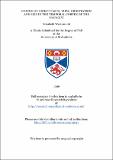Coding of object parts, view, orientation and size in the temporal cortex of the macaque
Abstract
The study examined the importance of (1) component parts, (2) view, (3) orientation and (4) size in the neural encoding of the sight of a complex object in the temporal cortex of the macaque. Studies focused on cells selectively responsive to the sight of the head/body but unresponsive to control stimuli. (1) Cells responsive to the static whole body were tested with two component parts of the body. 44% (29/66) of cells responded to the whole body and to one of the two body regions tested: 23 to the head; 6 to the body. 36% (24/66) responded independently to both regions of the body when tested in isolation. The remaining cells were selective for the entire body and unresponsive to component parts. Similar selectivity for component parts was observed amongst cells responsive to moving heads/bodies (18 cells tested). (2) 90% (66/73) of cells (selectively responsive to static or moving head/bodies) tested were sensitive to perspective view (viewer-centred). Comparable levels of view sensitivity were found for responses to the whole body and its parts. Contrary to some influential models of object recognition these results indicate view-specific processing for both the appearance of separate object components and for integration of information across components. (3) The majority of cells tested (18/25, 72%) were selectively responsive to a particular orientation in the picture plane of the static whole body stimulus. 7 cells generalised across all orientations (4 cell with pure generalisation; 3 cells with superimposed orientation tuning). Of all cells sensitive to orientation, the majority (15/21, 71%) were tuned to the upright image. (4) The majority of cells tested (81%, 13/16) were selective for a particular stimulus size. The remaining cells (3/16) showed generalisation across a 4 fold decrease in size from life-sized. Interestingly, all size sensitive cells were tuned to life-sized stimuli. These results do not support previous suggestions that cells responsive to the head and body are selective to the view but generalise across orientation and size. Here, extensive selectivity for size and orientation is reported. It is suggested that object part, view, orientation and size specific responses might be pooled to obtain generalising responses. Experience appears to affect neuronal coding in two ways: a) Cells become selective for multiple object components due to spatial and temporal association between parts; and b) more cells become tuned to views, orientations and image sizes commonly experienced.
Type
Thesis, PhD Doctor of Philosophy
Collections
Items in the St Andrews Research Repository are protected by copyright, with all rights reserved, unless otherwise indicated.

